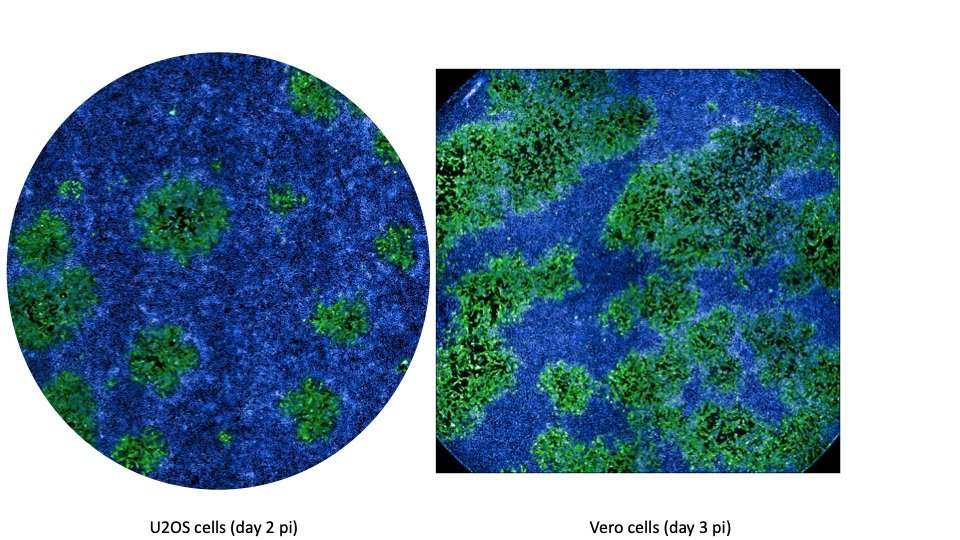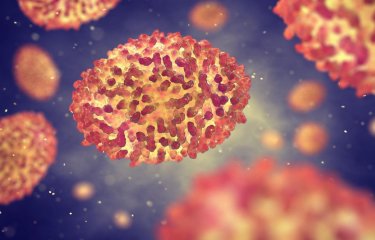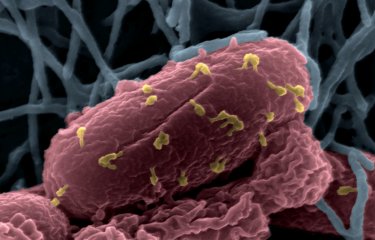Physicians and scientists from the Institut Pasteur, the Pasteur Network and ANRS | Emerging Infectious Diseases have conducted a review of the medical and scientific literature about monkeypox. The review, which paints a complete picture of the disease, was published in the New England Journal of Medicine on October 26, 2022. What are the signs of this disease? Where does it come from? How is it transmitted? Which populations are affected? How can we contain this type of emergence? While exploring these questions, let’s also review related projects (as AFRIPOX) supported by the Institut Pasteur and its partners.
Monkeypox is caused by the monkeypox virus, which belongs to the same family as the smallpox virus. After initially occurring in animals in Africa (especially squirrels and rats), the virus now circulates in humans. Diseases that follow this pattern of interspecies transmission from animals to humans are known as emerging zoonoses. Monkeypox is transmitted through contact with skin lesions or infected bodily fluids. The disease is primarily characterized by a skin rash which lasts for one to two weeks. In the vast majority of cases it clears up on its own, and severe forms are rare, occurring mainly in children and immunocompromised patients. The name of the disease can be a source of confusion: although the monkeypox virus was initially isolated in a monkey colony, it is probably transmitted to humans from rodents in African tropical rainforests (see the Monkeypox fact sheet). However, the precise animal reservoir(s) have not yet been formally identified.
A review of the scientific literature to understand monkeypox
Three scientists have conducted a review of the medical and scientific literature to establish a comprehensive picture of the latest information about monkeypox:
- Antoine Gessain, Head of the Institut Pasteur's Oncogenic Virus Epidemiology and Pathophysiology Unit and a member of the scientists' collective for the AFRIPOX project (see below);
- Emmanuel Nakoune, Head of the Viral Hemorrhagic Fevers Department at the Institut Pasteur de Bangui and a member of the scientists' collective for the AFRIPOX project;
- Yazdan Yazdanpanah, Head of the Infectious Diseases Department at Bichat Hospital, Paris (which received and monitored several monkeypox patients who were diagnosed in France from May 2022 onwards, when the current outbreak started), and Director of ANRS | Emerging Infectious Diseases.
The main findings of their research, published in the New England Journal of Medicine on October 26, 2022, are summarized on the fact sheet at pasteur.fr (cause, transmission, symptoms, diagnosis, epidemiology, prevention and vaccination, treatment and management).
The scientists outline the context in which monkeypox first emerged. It is an emerging human infectious disease that originated in forested areas and was identified in humans for the first time in 1970 in the Democratic Republic of the Congo. Most cases have been reported in mainly rural areas and tropical rainforest regions in Central and West Africa. A few sporadic cases were identified in the United States from 2003 onwards, imported by infected animals or, from 2017-2018 onwards, by travelers coming back from endemic areas in West Africa.
The significant increase in the number of cases in recent decades, can partly be explained by the global decline in immunity conferred by the smallpox vaccine following the discontinuation of the vaccination program in the 1980s (see the Institut Pasteur's retrospective analysis in July 2020). But there are also other contributory factors which have shifted over the past 30 years, including deforestation and growing urbanization. These ecosystem pressures caused by human activity are leading to an increase in human-wildlife interactions and are changing structures and dynamics among animal communities. A final important point to note is that socio-economic instability and civil war are increasing the risk of the virus being transmitted from animals to humans.
Since May 2022, a vast outbreak has been observed worldwide (nearly 80,000 cases by October 2022 – see the data on the website of the CDC, the US Centers for Disease Control and Prevention) and was declared a "public health emergency of international concern" by the World Health Organization (WHO) in July 2022. The recent outbreak is characterized by a pattern of transmission linked to sexual contact, which was rarely observed in previous outbreaks. It mostly affects men who have sex with men, but not exclusively. In some cases, the clinical and epidemiological form of the disease differs considerably from the original form that affected populations in rural regions of Central Africa, but the case-fatality rate remains very low.
The authors conclude that:
- emerging diseases are phenomena that are difficult to predict in terms of their epidemic potential and the scale and diversity of the symptoms they cause;
- raising awareness among populations, developing more accurate diagnostic tools and evaluating the efficacy of existing treatments are all useful avenues for dealing with such diseases;
- long-term support for research programs on emerging diseases in low- and middle-income countries is crucial if we are to prepare collectively for future crises.
This last point – research into emerging diseases in low-income countries – is crucial.
These countries are particularly exposed to emerging diseases because of rapid population growth and increasing contact between populations and wildlife in nearby forests. "This is why significant resources need to be allocated to and within local teams, in order to tackle and prevent the spread of emerging diseases and the outbreak of pandemics," emphasize the study's authors.
This was the idea behind a dedicated monkeypox research program launched nearly ten years ago in the Central African Republic (CAR) with the support of the Institut Pasteur, a member of the Pasteur Network, which has institutes in several endemic areas, in this case in the CAR via the Institut Pasteur de Bangui. The collaborative research program (see inset below) has already resulted in a dozen publications on the subject describing the situation in the CAR before the 2022 outbreak, clearly demonstrating the importance of support for this type of project in endemic areas. This is also one of the missions of ANRS | Emerging Infectious Diseases, established in January 2021 (see the scientific monitoring performed by ANRS | Emerging Infectious Diseases, which provides key information about the Monkeypox outbreak that is updated on a regular basis from reliable sources).

Monkeypox: a long-standing collaborative effort at the Institut Pasteur
Over the past decade, initially supported by an Inter-Pasteurian Concerted Action (ACIP), intensive work has been carried out in the Central African Republic with the Institut Pasteur de Bangui in collaboration with the Oncogenic Virus Epidemiology and Pathophysiology Unit and the Laboratory for Urgent Response to Biological Threats (CIBU - page in French), mainly focusing on clinical and virological research. In 2018, a larger scale project known as AFRIPOX, particularly supported by the French National Research Agency (ANR), was developed between the Institut Pasteur, the Institut Pasteur de Bangui (both Pasteur Network members) and the French Museum of Natural History. The aim of AFRIPOX is to characterize animal reservoirs of the virus and their ecological habitats, as well as interactions between these reservoirs and human populations, through epidemiological and anthropological research. The project is being carried out in conjunction with the monkeypox surveillance process in the Central African Republic. By adopting a multidisciplinary approach to the disease, the long-term goal is to identify practices that will help prevent future emerging zoonoses.
Several experts from the Institut Pasteur are currently working on the project, which is currently led by Arnaud Fontanet, Head of the Epidemiology of Emerging Diseases Unit. In addition to Arnaud Fontanet's team, AFRIPOX also involves the teams led respectively by Tamara Giles-Vernick (Anthropology and Ecology of Disease Emergence), Antoine Gessain (Oncogenic Virus Epidemiology and Pathophysiology), Jean-Claude Manuguerra (Environment and Infectious Risks), and Emmanuel Nakoune at the Institut Pasteur de Bangui.
The Pasteur Network has also recently developed and validated rapid detection tests for monkeypox, based on research led by the teams of Emmanuel Nakoune and Nicolas Berthet, currently a scientist in the Institut Pasteur's Oncogenic Virus Epidemiology and Pathophysiology Unit.
The Pasteur Network is present in several endemic areas in 25 countries. This network, which includes more than 30 members at the forefront of efforts to improve the health of populations worldwide, has repeatedly played a major role in guarding against emerging infectious diseases, including Ebola in West Africa in 2014 and its resurgence (page in French), plague in Madagascar in 2017, COVID-19 and monkeypox in recent months.
Source
Review article: Monkeypox, New England Journal of Medicine, October 26, 2022
DOI: 10.1056/NEJMra2208860
Antoine Gessain, M.D.(1), Emmanuel Nakoune, Ph.D. (2), and Yazdan Yazdanpanah, M.D. (3)
- Institut Pasteur, Université Paris Cité, Centre National de la Recherche Scientifique, UMR3569, unité d’Épidémiologie et Physiopathologie des Virus Oncogènes, Département de Virologie, Paris (France).
- Institut Pasteur de Bangui, Bangui (République Centrafricaine).
- Assistance Publique-Hôpitaux de Paris, Department of Infectious and Tropical Diseases, Bichat-Claude Bernard University Hospital, INSERM, ANRS | Maladies infectieuses émergentes, Paris (France).





